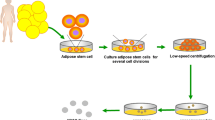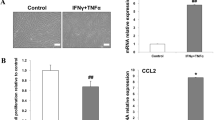Abstract
Adipose-derived stem cells (ADSCs) hold great promise for repair and regeneration of burn wounds by producing growth factors, but proinflammatory cytokines such as interleukin-8 (IL-8) released by ADSCs would potentially deepen the wound and inhibit healing. The reported research aimed to identify the effects of N-acetyl-l-cysteine (NAC) on the proliferation, death, and IL-8 production of ADSCs. In the presence or absence of NAC, ADSC proliferation was examined using a CCK-8 Kit, and cell death was evaluated by flow cytometry analysis. Subsequently, IL-8 mRNA expression was detected by reverse transcriptase-polymerase chain reaction and protein production by enzyme-linked immunoassay. Findings showed that cell proliferation in the NAC-treated group was a significant 1.53-fold greater than in the control group, that the apoptosis rate of ADSCs decreased by 55.4 % compared with the control group, and that the necrosis rate decreased by 48.8 %. Additionally, the IL-8 mRNA expression decreased to 46.2 ± 8.7 % that of the control group, and the IL-8 protein production decreased to 9.98 ± 0.57 %. The authors believe that NAC might be helpful in burn wound repair and regeneration by stimulating the proliferation of ADSCs, inhibiting cell death, and suppressing IL-8 production.
Level of Evidence II
This journal requires that authors assign a level of evidence to each article. For a full description of these Evidence-Based Medicine ratings, please refer to the Table of Contents or the online Instructions to Authors www.springer.com/00266.




Similar content being viewed by others
References
Abe M, Takiguchi Y, Ichimaru S et al (2008) Comparison of the protective effect of N-acetylcysteine by different treatments on rat myocardial ischemia-reperfusion injury. Pharmacol Sci 106:571–578
Aggarwal A, Misro MM, Maheshwari A et al (2012) Differential modulation of apoptotic gene expression by N-acetyl-l-cysteine in Leydig cells stimulated persistently with hCG in vivo. Mol Cell Endocrinol 348:155–164
Ashcroft GS, Mills SJ, Lei K et al (2003) Estrogen modulates cutaneous wound healing by downregulating macrophage migration inhibitory factor. J Clin Invest 111:1309–1318
Bucky LP, Vedder NB, Hong HZ et al (1994) Reduction of burn injury by inhibiting CD18-mediated leukocyte adherence in rabbits. Plast Reconstr Surg 93:1473
Carroll JE, Howard EF, Hess DC et al (1998) Nuclear factor-kappa B activation during cerebral reperfusion: effect of attenuation with N-acetylcysteine treatment. Brain Res Mol Brain Res 56:186–191
Crenesse D, Schmid-Alliana A, Hornoy J et al (2000) Hypoxia-reoxygenation differentially stimulates stress-activated protein kinases in primary-cultured rat hepatocytes. Transpl Int 13(Suppl 1):S597–S599
Cross AS, Sakarya S, Rifat S et al (2003) Recruitment of murine neutrophils in vivo through endogenous sialidase activity. J Biol Chem 278:4112–4120
Cui L, Yin S, Liu W et al (2007) Expanded adipose-derived stem cells suppress mixed lymphocyte reaction by secretion of prostaglandin E2. Tissue Eng 13:1185–1195
Gehmert S, Gehmert S, Hidayat M et al (2011) Angiogenesis: the role of PDGF-BB on adipose-tissue derived stem cells (ASCs). Clin Hemorheol Microcirc 48:5–13
Giardina S, Michelotti A, Zavattini G et al (2010) Efficacy study in vitro: assessment of the properties of resveratrol and resveratrol +N-acetyl-cysteine on proliferation and inhibition of collagen activity. Minerva Ginecol 62:195–201
Gougerot-Pocidalo MA, el Benna J, Elbim C et al (2002) Regulation of human neutrophil oxidative burst by pro- and antiinflammatory cytokines. J Soc Biol 196:37–46
Hildebrand F, Pape HC, Krettek C (2005) The importance of cytokines in the posttraumatic inflammatory reaction. Unfallchirurg 108(793–794):796–803
Iocono JA, Colleran KR, Remick DG et al (2000) Interleukin-8 levels and activity in delayed-healing human thermal wounds. Wound Repair Regen 8:216–225
Ji H, Liu Y, Zhao X et al (2011) N-acetyl-l-cysteine enhances the osteogenic differentiation and inhibits the adipogenic differentiation through up regulation of Wnt 5a and down regulation of PPARG in bone marrow stromal cells. Biomed Pharmacother 65:369–374
Jung H, Kim HH, Lee DH et al (2011) Transforming growth factor-beta 1 in adipose derived stem cells conditioned medium is a dominant paracrine mediator determines hyaluronic acid and collagen expression profile. Cytotechnology 63:57–66
Kilroy GE, Foster SJ, Wu X et al (2007) Cytokine profile of human adipose-derived stem cells: expression of angiogenic, hematopoietic, and pro-inflammatory factors. J Cell Physiol 212:702–709
Kim EK, Li G, Lee TJ, Hong JP (2011) The effect of human adipose-derived stem cells on healing of ischemic wounds in a diabetic nude mouse model. Plast Reconstr Surg 128:387–394
Kim WS, Park BS, Sung JH (2009) The wound-healing and antioxidant effects of adipose-derived stem cells. Expert Opin Biol Ther 9:879–887
Kozer E, Koren G (2001) Management of paracetamol overdose: current controversies. Drug Saf 24:503–512
Lee EY, Xia Y, Kim WS et al (2009) Hypoxia-enhanced wound-healing function of adipose-derived stem cells: increase in stem cell proliferation and upregulation of VEGF and bFGF. Wound Repair Regen 17:540–547
Lim TC, Toh WS, Wang LS et al (2012) The effect of injectable gelatin-hydroxyphenylpropionic acid hydrogel matrices on the proliferation, migration, differentiation, and oxidative stress resistance of adult neural stem cells. Biomaterials 33:3446–3455
Matsumoto K, Hashimoto S, Gon Y (1998) Proinflammatory cytokine-induced and chemical mediator-induced IL-8 expression in human bronchial epithelial cells through p38 mitogen-activated protein kinase-dependent pathway. J Allergy Clin Immunol 101:825–831
Mileski W, Borgstrom D, Lightfoot E et al (1992) Inhibition of leukocyte-endothelial adherence following thermal injury. J Surg Res 52:334
Minamikawa H, Yamada M, Deyama Y et al (2011) Effect of N-acetylcysteine on rat dental pulp cells cultured on mineral trioxide aggregate. J Endod 37:637–641
Nwariaku F, Sikes PJ, Lightfoot E Jr et al (1996) Inhibition of selectin- and integrin-mediated inflammatory response after burn injury. J Surg Res 63:355
Rehman J, Traktuev D, Li J et al (2004) Secretion of angiogenic and anti-apoptotic factors by human adipose stromal cells. Circulation 109:1292–1298
Schreml S, Babilas P, Fruth S et al (2009) Harvesting human adipose tissue-derived adult stem cells: resection versus liposuction. Cytotherapy 11:947–957
Tu Q, Valverde P, Chen J (2006) Osterix enhances proliferation and osteogenic potential of bone marrow stromal cells. Biochem Biophys Res Commun 341:1257–1265
Zhang QG, Tian H, Li HC et al (2006) Antioxidant N-acetylcysteine inhibits the activation of JNK3 mediated by the GluR6-PSD95-MLK3 signaling module during cerebral ischemia in rat hippocampus. Neurosci Lett 408:159–164
Zhou GS, Su ZY, Cai YR et al (2007) Different effects of nanophase and conventional hydroxyapatite thin films on attachment, proliferation, and osteogenic differentiation of bone marrow-derived mesenchymal stem cells. Biomed Mater Eng 17:387–395
Acknowledgments
This research was supported by a grant from the National Natural Science Foundation of China (Grant No. 81071579).
Author information
Authors and Affiliations
Corresponding author
Rights and permissions
About this article
Cite this article
Xiong, L., Sun, J., Hirche, C. et al. In Vitro N-Acetyl-l-Cysteine Promotes Proliferation and Suppresses Interleukin-8 Expression in Adipose-Derived Stem Cells. Aesth Plast Surg 36, 1260–1265 (2012). https://doi.org/10.1007/s00266-012-9960-8
Received:
Accepted:
Published:
Issue Date:
DOI: https://doi.org/10.1007/s00266-012-9960-8




